- Established 1982 -HOME: www.hiltonpond.org
THIS WEEK at HILTON POND Subscribe for free to our award-winning nature newsletter (Back to Preceding Week; on to Next Week) |
TWO VENERABLE HUMMINGBIRDS, TRUMPET CREEPER, New Ruby-throated Hummingbirds (RTHU) are still showing up and getting banded in late May 2022 at Hilton Pond Center. The earliest females--some of which arrived the first half of April--have already mated and are sitting on eggs and perhaps nestlings. Mothers far enough along to have young have been grabbing insects and visiting our sugar water feeders much more frequently this week, apparently gathering food for hungry mouths in the nest. As a result, we've been catching mostly adult female RTHU in our mist nets, banding them quickly, and sending them on their way so as not to interfere with their maternal duties. At 9:30 a.m. on 26 May we caught a female ruby-throat that already had a band on her leg, so we only had to weigh and measure her before release. We also recorded her band number (M08269) and referred to our extensive database that told us something amazing: We first captured her at Hilton Pond on 05 June 2018 as an adult, meaning she had to have hatched not later than 2017. This calculates to make her an "after-fifth-year" bird in at least her SIXTH-year. (We also caught her in 2019 and 2020 but missed her last year.) We find it remarkable this bird the size of your thumb can leave our little 11-acre site in York SC, fly a thousand miles or more to the Neotropics, and come right back to the very same spot year-to-year.
All text, maps, charts & photos © Hilton Pond Center We were feeling pretty good about this particular recapture of an "old" Ruby-throated Hummingbird, but at 2:20 p.m. we netted ANOTHER banded female (that's her--L42890--in the photo above). When we checked our records, we were stunned. Even older than the morning bird, this female was banded here as a recent fledgling on 14 August 2016--making her a SEVENTH-year bird! Furthermore, we've caught her EVERY year since--a breathtaking example of longevity AND exact site fidelity for a bird that weighs less than a nickel! Imagine flying 1,500 miles to the Neotropics and finding your way back to the same little locale in York SC USA!
In actuality, hummingbird site fidelity at Hilton Pond Center is far more accurate than to just 11 acres. As shown on the table above, recapture dates for seven-year-old L42890 were quite similar--occurring the last week in May except for 2018--but more remarkable is that this female ruby-throat was caught at generally the same location (B) and, in three years, precisely the same location and trap! For folks who think hummingbirds are somehow traumatized by the banding experience, we offer these data as evidence ruby-throats are so unfazed they re-enter the same trap over and over and over again . . . week after week after week . . . year after year after year!
The evening of 26 May we were still breathing hard over the excitement and wonderment of recapturing two venerable female Ruby-throated Hummingbirds that--once again--validated Hilton Pond Center's long-term, 39-year banding studies of this common but enigmatic species. Our on-going research through Operation RubyThroat: The Hummingbird Project would not be possible without the support of folks like you and our Facebook readers, so please help underwrite our efforts with a contribution by clicking on a link below. Your gift, big or small, really DOES make a difference! All text, maps, charts & photos © Hilton Pond Center
Checks also can be sent to Hilton Pond Center at: All contributions are tax-deductible on your current-year income tax form. TRUMPER CREEPER AND HUMMINGBIRDS: As mentioned above, the season's earliest Ruby-throated Hummingbird nestlings are being fed by their mothers during late May, and within a week or two after that the first free-flying RTHU youngsters will show. (More commonly, broods fledge here sometime in July.) It's not coincidental--from a co-evolution standpoint--that right about now is also when initial blossoms of Trumpet Creeper, Campsis radicans, begin to appear. In fact, this year's first observations of those four-inch tubular flowers came on 31 May as a vigorous vine on a big log down near Hilton Pond burst forth in full sun with bright orange blooms.
All text, maps, charts & photos © Hilton Pond Center Yes, indeed, Trumpet Creeper inflorescence erupts just at the time when Ruby-throated Hummingbirds could use a nectar boost, with early breeding females needing to satisfy gaping maws of fast-growing chicks. After a late May/early June debut, Trumpet Creeper vines continue to flower well into summer and feeding the nectivorous masses, not slowing down until September just after the initial southbound RTHU migration begins.
All text, maps, charts & photos © Hilton Pond Center We realize some gardeners don't like Trumpet Creeper because it can be a little rambunctious, but we think anyone serious about feeding ruby-throats simply must have at least one vine in the backyard landscape. Plant it at the base of a big tree and whack it back occasionally if need be, but rest assured showy Trumpet Creeper flowers (above) WILL attract Ruby-throated Hummingbirds--maybe even faster than those sugar water feeders that take time, effort, and money to maintain. (P.S. When pruning, don't forget Trumpet Creeper flowers arise from this year's growth--not from older, woodier stems.) All text, maps, charts & photos © Hilton Pond Center TRUMPET CREEPER:
All text, maps, charts & photos © Hilton Pond Center And speaking of nectar-eaters, Ruby-throated Hummingbirds certainly aren't the only species to benefit from Trumpet Creeper's hidden sweetness. Myriad creatures are drawn to the vine's copious nectar--especially insects like the unidentified bee in the bottom flower above. We've seen arthropods from ants to Carpenter Bees and Pillbugs to beetles getting a sugar fix inside Trumpet Creeper's orange corolla, and we've always suspected various climbing mice and Eastern Gray Squirrels might nibble on the flowers to get at the nectar. One thing's for sure--birds other than hummingbirds also feed on Trumpet Creeper blossoms.
All text, maps, charts & photos © Hilton Pond Center Those other birds might not have long, straight bills or be able to hover while feeding, but some do show adaptations that allow them to take nectar from long, tubular flowers. In fact, we caught one of those avian species this week: A yellowish second-year female Orchard Oriole (OROR, above) armed with a sharply pointed scythe-like bill. That bi-colored bill is the oriole's secret weapon when it comes to eating flower nectar. In the case of Trumpet Creeper,
All text, maps, charts & photos © Hilton Pond Center Beginning this week Hilton Pond Center will have plenty of Trumpet Creeper flowers to satisfy summer sugar cravings of the many Carpenter Bees and Ruby-throated Hummingbirds likely to appear. They're not likely to get much competition from our local Orchard Orioles, however, since we don't host many. In fact, this week's female OROR was just our 58th banded in 41 years, with the good news being she had a prominent brood patch indicating she is nesting on-site. We haven't yet seen her mate, but he probably looks pretty much like a black-and-brick-red male (below) we captured and banded on his non-breeding grounds down in Costa Rica in 2008. (Note he also has a bi-colored, scythe-like bill--plus a prominent white wingbar like the female's.)
All text, maps, charts & photos © Hilton Pond Center Incidentally, during our Neotropical expeditions through Operation RubyThroat: The Hummingbird Project we observed several non-migratory species of orioles along with Orchard Orioles and Northern Orioles that breed in North America. Despite their brilliant plumage, all are members of the Blackbird Family (Icteridae), and all were apparent nectar source competitors with Ruby-throated Hummingbirds. At our study site in Guanacaste Province, Costa Rica, for example, a male Northern Oriole (below) went bill-to-bill with hummers feeding on abundant nectar within tubular yellow flowers of commercially grown Aloe Vera.
All text, maps, charts & photos © Hilton Pond Center If you haven't already done so, we hope you'll plant a Trumpet Creeper vine on your own property. You might not want the jumble of vines we tolerate--actually, encourage--at Hilton Pond Center, but the joys of watching Ruby-throated Hummingbirds feed from creeper's big orange flowers are countless. Who knows, you might even catch one of those thieving orioles in the act of nectar-robbing. All text, maps, charts & photos © Hilton Pond Center HILTON POND SUNSETS "Never trust a person too lazy to get up for sunrise
All text, maps, charts & photos © Hilton Pond Center Sunset over Hilton Pond, 23 May 2022 There were tornadoes not far to our west but we only got big rain here at the Center. The trusty digital rain gauge collected 0.95". Don't forget to scroll down for lists of Hilton Pond supporters and of all birds banded and recaptured during the period. Photoshop image post-processing for this page employs |
||||||||||||||||||||||||||||||||||||||||||||||||||
|---|---|---|---|---|---|---|---|---|---|---|---|---|---|---|---|---|---|---|---|---|---|---|---|---|---|---|---|---|---|---|---|---|---|---|---|---|---|---|---|---|---|---|---|---|---|---|---|---|---|---|
|
"This Week at Hilton Pond" is written and photographed by Dr. Bill Hilton Jr., executive director of Hilton Pond Center for Piedmont Natural History
|
|
|
Please refer "This Week at Hilton Pond" to others by clicking on this button: |
|


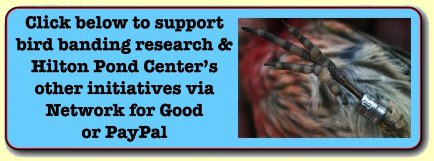


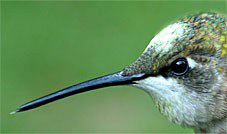 It's pretty obvious a tubular flower with a big nectar load is a cornucopia for a tiny nectar-eating bird with a long bill. That's why we call Trumpet Creeper--which grows through much of the vast Ruby-throated Hummingbird breeding range--the
It's pretty obvious a tubular flower with a big nectar load is a cornucopia for a tiny nectar-eating bird with a long bill. That's why we call Trumpet Creeper--which grows through much of the vast Ruby-throated Hummingbird breeding range--the 


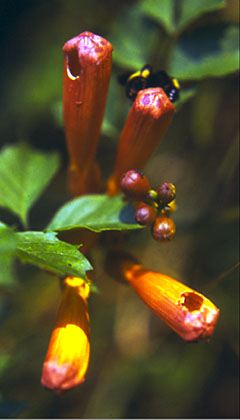 the four-inch floral tube is too deep for an OROR to reach the nectaries via the front entry used by hummingbirds, so the oriole slashes through the base of the tube with its sharp bill and "steals" its lunch. This does the Trumpet Creeper no favors, of course, since it damages fused petals AND bypasses pistil and stamens at the flower opening--meaning no pollination occurs. For Orchard Orioles "nectar robbing" is the name of the game.
the four-inch floral tube is too deep for an OROR to reach the nectaries via the front entry used by hummingbirds, so the oriole slashes through the base of the tube with its sharp bill and "steals" its lunch. This does the Trumpet Creeper no favors, of course, since it damages fused petals AND bypasses pistil and stamens at the flower opening--meaning no pollination occurs. For Orchard Orioles "nectar robbing" is the name of the game. 
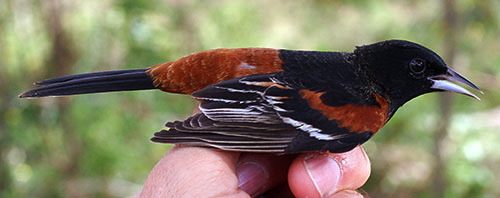
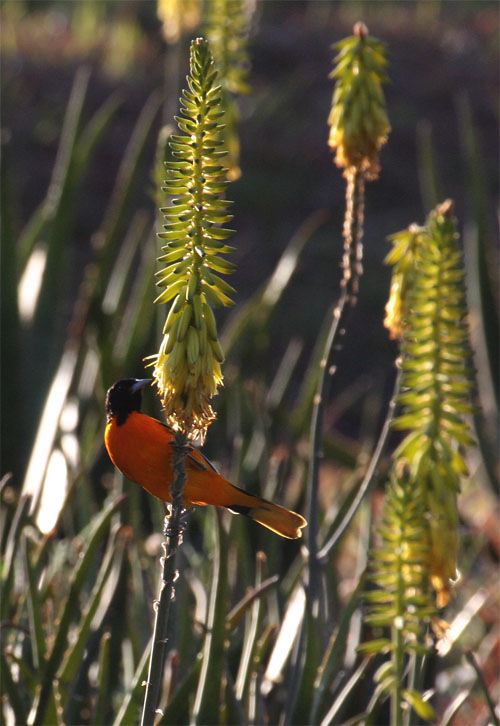









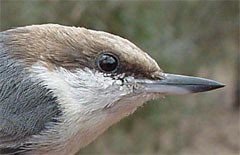
 Please report your
Please report your